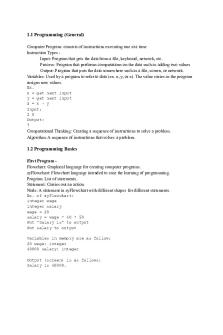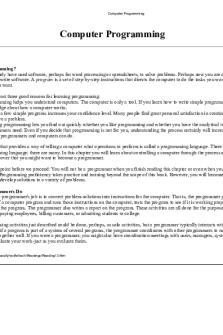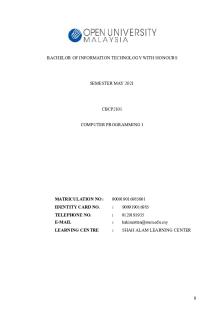Com s - Summary Applied Computer Programming. PDF

| Title | Com s - Summary Applied Computer Programming. |
|---|---|
| Course | Applied Computer Programming. |
| Institution | Iowa State University |
| Pages | 15 |
| File Size | 183.7 KB |
| File Type | |
| Total Downloads | 59 |
| Total Views | 144 |
Summary
Course...
Description
Computer Science (COM S) 1
COMPUTER SCIENCE (COM S)
COMS105B: Short Course in Computer Programming: MATLAB
Any experimental courses offered by COM S can be found at:
Prereq: Com S 104
registrar.iastate.edu/faculty-staff/courses/explistings/ (http://
8-week course in programming using MATLAB.
www.registrar.iastate.edu/faculty-staff/courses/explistings) Courses primarily for undergraduates:
(2-0) Cr. 2.
COMS106: Introduction to Web Programming (3-0) Cr. 3. F.S. Introduction to web programming basics. Fundamentals of developing
COMS101: Orientation
web pages using a comprehensive web development life cycle.
Cr. R. F.S.
Learn to code programs and earn in-depth experience with current
Introduction to the computer science discipline and code of ethics, Com
web design techniques such as HTML5 and cascading style sheets.
S courses, research and networking opportunities, procedures, policies,
Programming with JavaScript, jQuery, PHP, SQL, and MySQL. Strategies
help and computing resources, extra-curricular activities offered by the
for accessibility, usability and search engine optimization. No prior
Department of Computer Science and Iowa State University. Discussion
computer programming experience necessary.
of issues relevant to student adjustment to college life. Offered on a satisfactory-fail basis only. Offered on a satisfactory-fail basis only.
COMS107: Windows Application Programming (3-0) Cr. 3. F.S.
COMS103: Computer Literacy and Applications
Introduction to computer programming for non-majors using a language
Cr. 4. F.S.SS.
such as the Visual Basic language. Basics of good programming and
Introduction to computer literacy and applications. Literacy: Impact of
algorithm development. Graphical user interfaces.
computer technology in today’s societies, hardware, software, software programming, database and information systems, communication
COMS108: Applied Computer Programming for Non-Majors
and networks, digital media technology, computer security and safety,
(3-0) Cr. 3.
ethics and privacy. Applications: In-depth hands-on experience with the
Prereq: Com S 107 or equivalent
operating systems, Microsoft word processing, spreadsheets, database
Advanced programming applications in Visual Basic for non-majors.
management and presentation software. No prior computer experience
Emphasis on programming projects including sorting, file processing,
necessary. Offered online only. Attendance required at an orientation
database processing, web programming, and graphics and animation.
session the first week of class.
Students will learn problem solving techniques and advanced programming skills to build real-world applications.
COMS104: Brief Introduction to Computer Programming for Non-Majors (1.5-1) Cr. 2. F.S.
COMS113: Introduction to Spreadsheets and Databases
Offered first 8 weeks and last 8 weeks. Use of personal computer and
(2-2) Cr. 3. F.S.SS.
workstation operating systems and beginning programming. Project-
Using Microsoft Excel spreadsheets and Microsoft Access databases to
oriented approach to computer operation and programming, including
input, store, process, manipulate, query, and analyze data for business
use of tools to aid in programming. Topics from computer history,
and industrial applications. Credit in Com S 113 may not be applied
using basic Windows and Unix tools, program structure, expression,
toward graduation in the COM S, S E, and CPR E majors.
variables, decision and logic, and iteration. No prior computer experience necessary.
COMS127: Introduction to Computer Programming (3-2) Cr. 4. F.S.
COMS105: Short Course in Computer Programming
Prereq: Credit or Enrollment in MATH 140 or higher
Cr. 2.
Introduction to computer programming with an emphasis on problem
Prereq: Com S 104
solving. Topics include: program structures, expressions, variables,
8-week course in programming, including instruction in syntax and
decision and logic, iteration, collections, input and output. Program
semantics, of the following current programming languages.
construction and testing. Programming assignments including games and applications. No prior programming experience necessary. This
COMS105A: Short Course in Computer Programming: Perl (1-2) Cr. 2. Prereq: Com S 104 8-week course in programming using Perl.
course is intended for Computer Science majors.
2 Computer Science (COM S)
COMS203: Careers in Computer Science
COMS228: Introduction to Data Structures
Cr. R. F.S.
(3-1) Cr. 3. F.S.SS.
Computer science as a profession. Introduction to career fields open
Prereq: Minimum of C- in COM S 227, credit or enrollment in MATH 165
to computer science majors. Relationship of coursework to careers.
An object-oriented approach to data structures and algorithms. Object-
Presentations by computer science professionals. Offered on a
oriented analysis, design, and programming, with emphasis on data
satisfactory-fail basis only.
abstraction, inheritance and subtype polymorphism, and generics. Abstract data type specification and correctness. Collections including
COMS207: Fundamentals of Computer Programming (Cross-listed with MIS). (3-1) Cr. 3. F.S.SS. Prereq: MATH 150 or placement into MATH 140 or higher An introduction to computer programming using an object-oriented programming language. Emphasis on the basics of good programming techniques and style. Extensive practice in designing, implementing,
lists, stacks, queues, trees, heaps, maps, hash tables, and graphs. Big-O notation and algorithm analysis. Searching and sorting. Graph search and shortest path algorithms. Emphasis on object-oriented design, writing and documenting medium-sized programs. This course is designed for majors.
and debugging small programs. Use of abstract data types. Interactive
COMS230: Discrete Computational Structures
and file I/O. This course is not designed for computer science, software
(Cross-listed with MATH). (3-1) Cr. 3. F.S.SS.
engineering, and computer engineering majors. Credit may not be applied
Prereq: Minimum of C- in COM S 227 and MATH 165; ENGL 150
toward graduation for both Com S 207/MIS 207 and Com S 227.
Concepts in discrete mathematics as applied to computer science. Logic, set theory, functions, relations, combinatorics, discrete probability, graph
COMS208: Intermediate Computer Programming (3-1) Cr. 3.
theory and number theory. Proof techniques, induction and recursion.
Prereq: MIS/COM S 207, credit or enrollment in MATH 151, MATH 160, or
COMS252: Linux Operating System Essentials
MATH 165
(3-0) Cr. 3. F.
Intermediate-level programming techniques. Emphasis on designing,
Prereq: CPR E 185 or S E 185 or COM S 127 or COM S 207 or COM S 227
writing, testing, debugging, and documenting medium-sized programs.
Introduction to installation, utilization, and administration of Linux
Data structures and their uses. Dynamic memory usage. Inheritance and
systems. Topics include open-source software, package installation and
polymorphism. Algorithm design and efficiency: recursion, searching, and
management, shell programming and command-line utilities, process
sorting. Event-driven and GUI programming. The software development
and service management, account management, network configuration,
process. This course is not designed for computer science, software
file sharing, interoperation with other computers and operating systems,
engineering and computer engineering majors. Credit may not be applied
automation, and system security.
toward the major in computer science, software engineering, or computer engineering.
COMS290: Independent Study Cr. arr. Repeatable, maximum of 6 credits. F.S.SS.
COMS227: Object-oriented Programming
Prereq: Permission of instructor
(3-2) Cr. 4. F.S.SS.
No more than 6 credits of Com S 290 or Com S 290H may be counted
Prereq: Credit or Enrollment in MATH 143 or higher; recommended: a previous
toward graduation.
high school or college course in programming or equivalent experience. Computer programming using objects as the mechanism for modularity, abstraction, and code reuse. Instance variables, methods, and encapsulation. Review of control structures for conditionals and iteration. Developing algorithms on strings, arrays, and lists. Recursion, searching, and sorting. Text parsing and file I/O. Interfaces, inheritance,
COMS290H: Independent Study: Honors Cr. arr. Repeatable, maximum of 6 credits. F.S. Prereq: Permission of instructor No more than 6 credits of Com S 290 or Com S 290H may be counted toward graduation.
polymorphism, and abstract classes. Exception handling. Tools for
COMS295: Programming-based problem solving practices
unit testing and debugging. Emphasis on a disciplined approach to
Cr. 1. Repeatable, maximum of 3 times. F.S.
specification, code development, and testing. Course intended for Com S
Prereq: COM S 207 or COM S 227
majors. Credit may not be applied toward graduation for both Com S 207
Basics of problem solving using programming techniques. Development
and 227.
and implementation of simple to advanced data structures and algorithms, evaluation of problem difficulty, design and implementation of solutions, debugging, and working under time pressure. Offered on a satisfactory-fail basis only.
Computer Science (COM S) 3
COMS309: Software Development Practices
COMS327: Advanced Programming Techniques
(Cross-listed with S E). (3-1) Cr. 3. F.S.
(3-0) Cr. 3. F.S.
Prereq: Minimum of C- in COM S 228 and MATH 165
Prereq: Minimum of C- in COM S 228 and MATH 165
A practical introduction to methods for managing software development.
Object-oriented programming experience using a language suitable for
Process models, requirements analysis, structured and object-oriented
exploring advanced topics in programming. Topics include memory
design, coding, testing, maintenance, cost and schedule estimation,
management, parameter passing, inheritance, compiling, debugging, and
metrics. Programming projects.
maintaining programs. Significant programming projects.
COMS311: Introduction to the Design and Analysis of Algorithms
COMS331: Theory of Computing
(3-1) Cr. 3. F.S.SS.
(Cross-listed with LING). (3-1) Cr. 3. F.S.
Prereq: Minimum of C- in COM S 228; MATH 166, ENGL 150; COM S 230 or
Prereq: Minimum of C- in COM S 228, MATH 166, and in COM S 230 or CPR E
CPR E 310
310; ENGL 250
Basic techniques for design and analysis of algorithms. Sorting,
Models of computation: finite state automata, pushdown automata and
searching, graph algorithms, string matching, and NP-completeness.
Turing machines. Study of grammars and their relation to automata.
Design techniques such as dynamic programming, divide and conquer,
Limits of digital computation, unsolvability and Church-Turing thesis.
greedy method, and approximation. Asymptotic, worst-case, average-case
Relations between classes of languages.
and amortized analyses. Topics from advanced data structures such as balanced trees and hashing.
COMS336: Introduction to Computer Graphics (3-0) Cr. 3. F.
COMS319: Construction of User Interfaces
Prereq: COM S 327, CoReq MATH 207 or MATH 317
(Cross-listed with S E). (3-0) Cr. 3. F.S.
Programming interactive computer graphics systems using standard
Prereq: COM S 228
low-level libraries (such as OpenGL or DirectX) with an emphasis
Overview of user interface design. Evaluation and testing of user
on 3D rendering. The graphics pipeline and programmable shaders.
interfaces. Review of principles of object orientation, object oriented
Coordinate systems and transformations in two and three dimensions.
design and analysis using UML in the context of user interface design.
Homogeneous coordinates, viewing transformations and perspective.
Design of windows, menus and commands. Developing Web and
Euler angles and quaternions. Visible surface algorithms. Lighting models
Windows-based user-interfaces. Event-driven programming. Introduction
and shading. Texture mapping, bump mapping, reflection, elementary ray
to Frameworks and APIs for the construction of user interfaces.
tracing. Offscreen buffers, render-to-texture and related techniques.
COMS321: Introduction to Computer Architecture and Machine-Level
COMS342: Principles of Programming Languages
Programming
(Cross-listed with S E). (3-1) Cr. 3. F.S.
(3-1) Cr. 3. F.S.
Prereq: Minimum of C- in COM S 228 and MATH 165; COM S 230 or CPR E 310
Prereq: Minimum of C- in COM S 228 and MATH 165; COM S 230 or CPR E 281;
Study of concepts in programming languages, especially functional
ENGL 250
programming concepts. Overview of major programming paradigms,
Introduction to computer architecture and organization. Emphasis on
their relationship, and tradeoffs among paradigms enabling sound
evaluation of performance, instruction set architecture, datapath and
choices of programming language for application-specific development.
control, memory-hierarchy design, and pipelining. Assembly language
Programming projects.
programming. COMS350: Number Theory COMS326: C for Programmers
(Cross-listed with MATH). (3-0) Cr. 3. S.
Cr. 1. F.S.
Prereq: MATH 201 or COM S 230
Prereq: Minimum of C- in COM S 228; COM S 230
Divisibility, integer representations, primes and divisors, linear
Half-semester course. Design and implementation of libraries and
diophantine equations, congruences, and multiplicative functions.
applications in C, for students with prior programming background.
Applications to cryptography. Additional topics, chosen at the discretion
Emphasis on differences between C and other languages, including file
of the instructor.
I/O, string processing, memory management, and buffer overruns. Using build systems, debuggers, and other development tools. Programming projects.
4 Computer Science (COM S)
COMS352: Introduction to Operating Systems
COMS402B: Computer Science Senior Project: Multimedia and
(3-1) Cr. 3. F.S.
Computer Gaming II
Prereq: COM S 321 or CPR E 381 and COM S 327 or CPR E 288; ENGL 250
Cr. 2-3. Repeatable, maximum of 6 credits. S.
Survey of operating system, networking and parallel programming issues.
Prereq: COM S 402A, Senior Classification
Introduction of processes, threads, process synchronization, deadlocks,
Students implement, test, and present a completed production computer
memory, file systems, networking, security threats and encryption.
game. Students in this class will work with students in ARTIS 409. Oral
Programming projects.
and written reports. No more than 6 credits of 402A, 402B, and 402C may be used toward graduation.
COMS362: Object-Oriented Analysis and Design (Cross-listed with S E). (3-0) Cr. 3. F.S.
COMS402C: Computer Science Senior Project: Project in Computer
Prereq: Minimum of C- in COM S 228 and MATH 165; ENGL 250
Science
Object-oriented requirements analysis and systems design. Design
(0-6) Cr. 2-3. Repeatable, maximum of 6 credits. F.S.
notations such as the Unified Modeling Language. Design Patterns.
Prereq: COM S 309, COM S 311, COM S 321, and COM S 331, Senior
Group design and programming with large programming projects.
Classification Students work as individuals and teams to complete the planning, design,
COMS363: Introduction to Database Management Systems (3-0) Cr. 3. F.S. Prereq: Minimum of C- in COM S 228 and MATH 165; ENGL 250 Relational, object-oriented, semistructured and query languages. SQL,
and implementation of a significant project in the topic area. Oral and written reports. No more than 6 credits of 402A, 402B, and 402C may be used toward graduation.
XML, and NO-SQL. Database design using entity-relationship model, data
COMS409: Software Requirements Engineering
dependencies, and relational database design. Application development
(Dual-listed with COM S 509). (3-0) Cr. 3.
in SQL-like languages and general purpose host languages with
Prereq: COM S 309; for graduate credit: graduate standing or permission of
application program interfaces and a commonly used Object Relational
instructor
Mapping framework. Web application development. Programming
The requirements engineering process including elicitation, requirements
Projects.
analysis fundamentals, requirements specification and communication, and requirements evaluation. Modeling of functional and nonfunctional
COMS398: Cooperative Education Cr. R. Repeatable. F.S.SS. Prereq: Permission of department chair
requirements, traceability, and requirements change management. Case studies and software projects.
Required of all cooperative education students. Students must register
COMS410: Distributed Development of Software
for this course prior to commencing each work period.
(Dual-listed with COM S 510). (3-0) Cr. 3. Prereq: COMS 228, COMS 309, COMS 327; for graduate credit: graduate
COMS402: Computer Science Senior Project Cr. 2-3. Repeatable, maximum of 6 credits. F.S. Prereq: COM S 309, COM S 311, COM S 321, COM S 331, ENGL 250, SP CM 212, and Senior Classification Students work as individuals and teams to complete the planning, design, and implementation of a significant project in the topic area. Oral and written reports. No more than 6 credits of 402A, 402B, and 402C may be used toward...
Similar Free PDFs

Computer Programming Laboratory 1
- 10 Pages

Computer Programming Notes
- 39 Pages

Computer Programming python
- 15 Pages

Computer programming viva qus
- 18 Pages

Summary of Java Programming
- 10 Pages

Computer networking summary notes
- 35 Pages
Popular Institutions
- Tinajero National High School - Annex
- Politeknik Caltex Riau
- Yokohama City University
- SGT University
- University of Al-Qadisiyah
- Divine Word College of Vigan
- Techniek College Rotterdam
- Universidade de Santiago
- Universiti Teknologi MARA Cawangan Johor Kampus Pasir Gudang
- Poltekkes Kemenkes Yogyakarta
- Baguio City National High School
- Colegio san marcos
- preparatoria uno
- Centro de Bachillerato Tecnológico Industrial y de Servicios No. 107
- Dalian Maritime University
- Quang Trung Secondary School
- Colegio Tecnológico en Informática
- Corporación Regional de Educación Superior
- Grupo CEDVA
- Dar Al Uloom University
- Centro de Estudios Preuniversitarios de la Universidad Nacional de Ingeniería
- 上智大学
- Aakash International School, Nuna Majara
- San Felipe Neri Catholic School
- Kang Chiao International School - New Taipei City
- Misamis Occidental National High School
- Institución Educativa Escuela Normal Juan Ladrilleros
- Kolehiyo ng Pantukan
- Batanes State College
- Instituto Continental
- Sekolah Menengah Kejuruan Kesehatan Kaltara (Tarakan)
- Colegio de La Inmaculada Concepcion - Cebu









